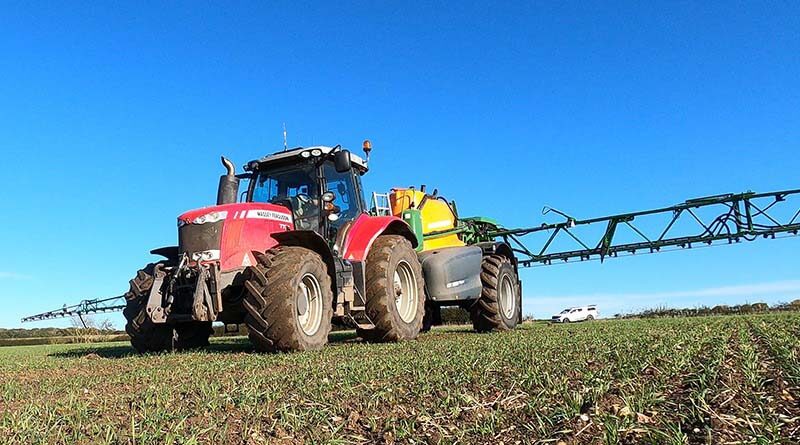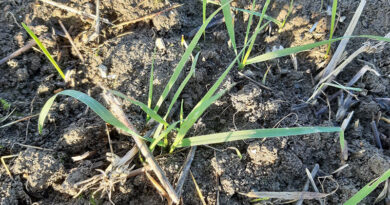Weed out wild oats
15 January 2022, UK: Exceptionally mild early winter weather has provided perfect conditions for winter wild oat germination and growth. Despite good performance of pre-emergence herbicides applied in the autumn, on the majority of the cereal acreage, record temperatures in December has seen continued weed and crop growth.
Growers and agronomists should now be on the lookout for wild oats during crop walking inspections, advocated Georgina Young, Syngenta Technical Manager (below). “Early identification of winter germinated wild oats will enable more effective targeting of herbicide programmes in the spring.

“Overwintered Winter wild oats (Avena sterilis) are more difficult to control, compared to later germinating common spring wild oats (Avena fatua). Mapping the extent of overwintered wild oats now, whilst they are more easily seen in the growing crop, will help with decision making for Axial Pro timing and application,” she advised.
Winter wild oats typically germinate between October and March; the earlier established and larger the weed, the more challenging it can be to control.
However, growers should be aware that common spring wild oats can also germinate in autumn or early winter. Overwintered weeds are more competitive with the crop, making their removal a priority.

“Challenges for wild oat control could be further compounded by the size of the crop canopy – which can make the prostrate grass weed target more difficult to hit – along with slow spring growing conditions that would limit herbicide uptake,” highlighted Georgina.
“For maximum efficacy, maintain higher herbicide rates and, where weeds are difficult to hit, adapt application technique according to crop and weed growth stage.”
With overwintered wild oats up to growth stage 29, she advises Axial Pro rate of 0.6 l/ha in good growing conditions, increasing up to the maximum 0.82 l/ha where growing conditions are compromised. For larger weeds, up to growth stage 39, the higher rate of 0.82 l/ha would be the default, she added.
“In recent seasons, spring growing conditions have been repeatedly sub-optimal, either through being very dry or unseasonably cool. That can seriously compromise the uptake of herbicide by weeds.
Also Read: Summit Carbon Solutions Partners with Blue Ammonia Project to Decarbonize Ag Supply Chain
“If growing conditions are poor, we would advocate higher application rates or, where wild oats are a particular problem, to make the Axial Pro application as a standalone treatment specifically targeted at the weed.”
For application targeted at exposed wild oats in an open crop canopy (less than GS29), operators should ideally use the medium droplets of an angled 3D Nozzle at 100 l/ha water volume (below), where spraying conditions permit.

As the crop grows, where weeds may be shaded within the larger canopy, application should be adapted to use coarser droplets, such as the Amistar Nozzle (below), and a higher water volume of 200 l/ha to achieve greater penetration down to the weeds.

Later germinating wild oats in the spring can be controlled with Axial Pro rates as low as 0.4 l/ha whilst still small (less than GS29), however rates would need to be higher where there are larger or mixed populations of over wintered weeds present. Adigor would also need to be added at the lower dose rate.
“There is always the timing balance between controlling those weeds already in the crop, with the potential for more wild oats to emerge,” Georgina acknowledged.
“The earlier weeds are removed the better for reduced crop competition and yield effects, coupled with taking advantage of any good application timing conditions,” she warned.
“If an application timing is missed and conditions turn sub-optimal, further opportunities for effective control may be limited.”

Georgina also pointed out that agronomists need to consider the sequencing of required herbicide treatments. If Axial Pro is used in an early application for wild oats and ryegrass, follow up treatments targeted at less competitive broad-leaved weeds can typically be made after seven days. But where an ALS inhibitor (from HRAC Group 2 or B) of a hormone herbicide (HRAC Group 4 or 0) has been applied, growers must wait 21 days before re-assessment and application of Axial Pro.
“In that time there is the risk that grass weeds could have grown significantly, and thus require more costly higher application rates to control, or conditions may have turned adverse for growth that may compromise results,”
“We would typically advocate Axial Pro first in the spring herbicide sequence, to achieve the earliest and most cost-effective control,” she advised.
The Syngenta four-point plan to tackle wild oats:
- Map field populations of wild oats over several seasons
- Identify the species of wild oat on your farm
- Plan your control strategy, taking into account likely germination patterns
- Test for resistance if poor control is identified
Follow the Axial Pro decision matrix for spring 2022 wild oat control programmes
















